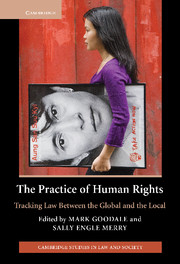Book contents
- Frontmatter
- Contents
- Contributors
- Acknowledgments
- Introduction Locating rights, envisioning law between the global and the local
- PART ONE STATES OF VIOLENCE
- PART TWO REGISTERS OF POWER
- PART THREE CONDITIONS OF VULNERABILITY
- Introduction
- 5 Rights to indigenous culture in Colombia
- 6 The 2000 UN Human Trafficking Protocol: rights, enforcement, vulnerabilities
- PART FOUR ENCOUNTERING AMBIVALENCE
- Conclusion Tyrannosaurus lex: the anthropology of human rights and transnational law
- Index
- References
6 - The 2000 UN Human Trafficking Protocol: rights, enforcement, vulnerabilities
Published online by Cambridge University Press: 29 March 2011
- Frontmatter
- Contents
- Contributors
- Acknowledgments
- Introduction Locating rights, envisioning law between the global and the local
- PART ONE STATES OF VIOLENCE
- PART TWO REGISTERS OF POWER
- PART THREE CONDITIONS OF VULNERABILITY
- Introduction
- 5 Rights to indigenous culture in Colombia
- 6 The 2000 UN Human Trafficking Protocol: rights, enforcement, vulnerabilities
- PART FOUR ENCOUNTERING AMBIVALENCE
- Conclusion Tyrannosaurus lex: the anthropology of human rights and transnational law
- Index
- References
Summary
“What are the consequences of the invisibility of many types of violence?” asks Balakrishnan Rajagopal in his critique of human rights discourse and state power (2003: 186). He observes that unrecognized violence is, by default, allowed to continue unchallenged; in that sense it is “authorized.” This chapter looks at attempts by the international community to name and combat human trafficking as a form of transnational violence invisible to many until recently but, in the mind of some, surging out of control. Responding to Rajagopal in this context leads me to pose an alternative set of questions: “What are the political dynamics of making violence visible, the consequences of naming and circumscribing human trafficking through a new round of international norms? How does this trajectory of international law become problematic for activists who claim that the wrong kinds of violence may be targeted by these norms?
To address these issues, this chapter examines the UN anti-trafficking protocol as a living document whose final language is consulted by parties around the globe who may know little about its genesis. In the genealogy of human trafficking as an urgent problem that requires international attention, the 2000 UN Protocol to Prevent, Suppress, and Punish Trafficking in Persons, Especially Women and Children has played the formative role as the generator of international norms.
In the genealogy of human trafficking as an urgent problem that needed to be addressed, the 2000 UN Protocol to Prevent, Suppress, and Punish Trafficking in Persons, Especially Women and Children played the formative role as the generator of international norms.
- Type
- Chapter
- Information
- The Practice of Human RightsTracking Law between the Global and the Local, pp. 242 - 270Publisher: Cambridge University PressPrint publication year: 2007
References
- 21
- Cited by



